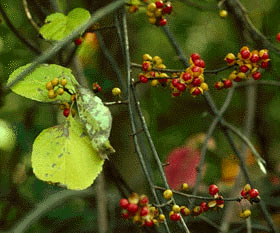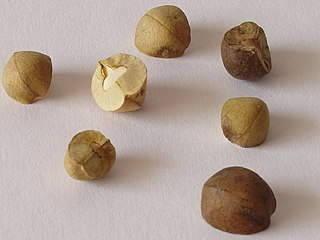
The gray catbird, also spelled grey catbird, is a medium-sized North American and Central American perching bird of the mimid family. It is the only member of the "catbird" genus Dumetella. Like the black catbird, it is among the basal lineages of the Mimidae, probably a closer relative of the Caribbean thrasher and trembler assemblage than of the mockingbirds and Toxostoma thrashers. In some areas it is known as the slate-colored mockingbird.

The grey-cheeked thrush is a medium-sized thrush. This species is 15–17 cm (5.9–6.7 in) in length, and has the white-dark-white underwing pattern characteristic of Catharus thrushes. It is a member of a close-knit group of migrant species together with the veery and Bicknell's thrush; it forms a cryptic species pair with the latter. The grey-cheeked thrush is all but indistinguishable from Bicknell's thrush except by its slightly larger size and different song. The two were formerly considered conspecific. Of all the American spotted thrushes, the grey-cheeked has the most northern breeding range.

The Celastraceae are a family of 98 genera and 1,350 species of herbs, vines, shrubs and small trees, belonging to the order Celastrales. The great majority of the genera are tropical, with only Celastrus, Euonymus and Maytenus widespread in temperate climates, and Parnassia (bog-stars) found in alpine and arctic climates.
Hawaiian hibiscus are seven species of hibiscus native to Hawaii. The yellow hibiscus is Hawaii's state flower. Most commonly grown as ornamental plants in the Hawaiian Islands are the non-native Chinese hibiscus and its numerous hybrids, though the native Hibiscus arnottianus is occasionally planted.

Mexican jumping beans are seed pods that have been inhabited by the larva of a small moth and are native to Mexico. The pod is usually tan to brown. They are from the shrub Sebastiania pavoniana, often also referred to as "jumping bean". However, they are not related to actual beans, but rather to spurges. The beans are considered non-toxic but are not generally eaten. In the spring, when the shrub is flowering, moths lay their eggs on the shrub's hanging seedpods. When the eggs hatch, tiny larvae bore into the immature green pods and begin to devour the seeds. The pods ripen, fall to the ground and separate into three smaller segments, and those segments are called Mexican jumping beans. As the tiny larvae inside curl up and uncurl, they hit the capsule's wall with their heads – and the bean jumps. They move more as temperatures rise, the larva eats away the inside of the bean and attaches itself to the inside of the bean with silk-like thread.

Linaceae is a family of flowering plants. The family is cosmopolitan, and includes about 250 species in 14 genera, classified into two subfamilies: the Linoideae and Hugonioideae. Leaves of the Linaceae are always simple; arrangement varies from alternate to opposite or whorled. The hermaphroditic, actinomorphic flowers are pentameric or, very rarely, tetrameric.

A grison is any mustelid in the genus Galictis. Native to Central and South America, the genus contains two extant species: the greater grison, which is found widely in South America, through Central America to southern Mexico; and the lesser grison, which is restricted to the southern half of South America.

Parnassiaceae Gray were a family of flowering plants in the eudicot order Celastrales. The family is not recognized in the APG III system of plant classification. When that system was published in 2009, Parnassiaceae were treated as subfamily Parnassioideae of an expanded family Celastraceae.

Notiosorex cockrumi, also called Cockrum's gray shrew or Cockrum's desert shrew, is a tiny species of shrews named in 2003. This red-toothed shrew, which is as light as a penny, is the first new mammal species from Arizona since 1977. Its range extends from Arizona to central Sonora, Mexico.

Ericameria nauseosa, commonly known as chamisa, rubber rabbitbrush, and gray rabbitbrush, is a shrub in the sunflower family (Aster) found in the arid regions of western North America.

Lepidospartum is a genus of North American desert shrubs in the daisy family. They are known commonly as broomsages or scalebrooms. These are tall, woody shrubs with stiff twiggy branches that resemble brooms. They are native to the southwestern United States and far northern Mexico. These shrub have thin, narrow, needlelike or scalelike leaves and bear yellow daisy flowers.

Arctostaphylos morroensis is a species of manzanita known by the common name Morro manzanita. This shrub is endemic to San Luis Obispo County, California, where it is known only from the vicinity of Morro Bay.

Arctostaphylos otayensis is a species of manzanita known by the common name Otay manzanita. This shrub is endemic to California, where it is native to the mountains of San Diego County.

The black-tailed jackrabbit, also known as the American desert hare, is a common hare of the western United States and Mexico, where it is found at elevations from sea level up to 10,000 ft (3,000 m). Reaching a length around 2 ft (61 cm), and a weight from 3 to 6 lb, the black-tailed jackrabbit is one of the largest North American hares. Black-tailed jackrabbits occupy mixed shrub-grassland terrains. Their breeding depends on the location; it typically peaks in spring, but may continue all year round in warm climates. Young are born fully furred with eyes open; they are well camouflaged and are mobile within minutes of birth, thus females do not protect or even stay with the young except during nursing. The average litter size is around four, but may be as low as two and as high as seven in warm regions.

Arctostaphylos silvicola is a species of manzanita known by the common names Bonny Doon or silverleaf manzanita. It is endemic to the sandhills of the southern Santa Cruz Mountains in California's Santa Cruz and Santa Clara counties.

Comarostaphylis diversifolia, known by the common names summer holly and California comarostaphylos, is a species of shrub in the heath family.
Pottingeria is a genus consisting of a single species, Pottingeria acuminata, a small tree or large shrub native to mountainous areas of southeast Asia.

Quercus turbinella is a North American species of oak known by the common names shruboak, turbinella oak, shrub live oak, and gray oak. It is native to Arizona, California, New Mexico, Utah, Colorado, and Nevada in the western United States. It also occurs in northern Mexico.

Baccharis salicina is a species of plant in the family Asteraceae. Common names include willow baccharis, and Great Plains false willow. It is a shrub found in North America where it grows in mildly saline areas.

















